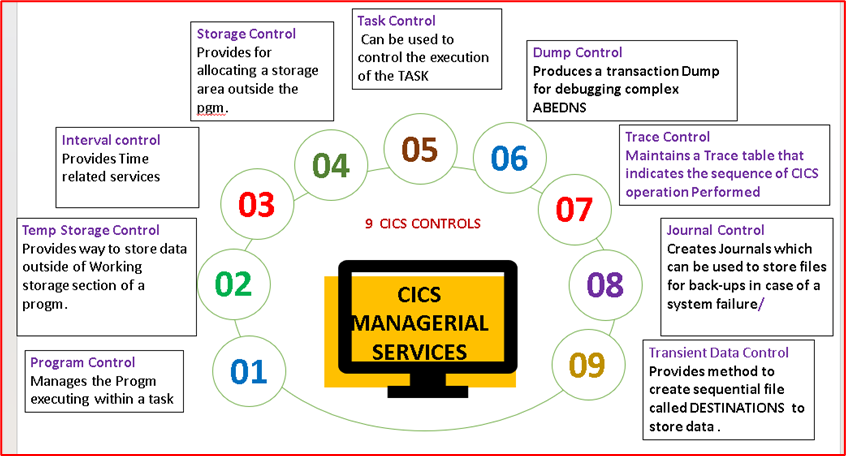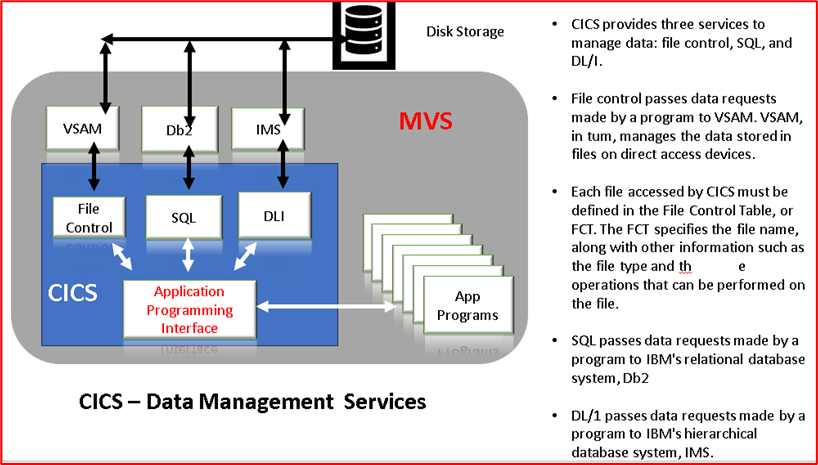Why CICS may be confused to look like an Operating system?
Captain Uday Prasad
CICS blurs the lines between middleware and operating systems?
CICS (Customer Information Control System) is often regarded as "operating-system-like" due to its ability to manage various services and resources for application programs. It offers a wide array of features that could make it seem like an operating system. However, while CICS provides many essential services, it is not an operating system.
To help differentiate the two, let's first examine the nine pillars of CICS that often lead to this confusion.
What is CICS?
CICS (Customer Information Control System) is a transaction processing monitor designed for handling high-volume, low-latency transactions in real time. It is primarily used on IBM mainframe computers. It is designed to handle high-volume, real-time transactions for mission-critical applications, such as those in banking, insurance, and retail. CICS acts as middleware, providing a platform that facilitates communication between application programs and the underlying operating system.
The 9 Key Pillars of CICS
1. Program Control: CICS provides a mechanism to control the flow of application programs, ensuring tasks are executed in the right order and that transactions are properly initiated, executed, and terminated.
2. Temporary Storage Control: CICS manages temporary data storage, enabling programs to store and retrieve data during the execution of transactions efficiently.
3. Interval Control: This pillar ensures smooth scheduling by controlling the intervals between transactions and optimizing task execution for maximum efficiency

4. Storage Control: CICS allocates and frees memory resources, handling memory usage across transactions within its controlled environment.
5. Task Control: This feature ensures that multiple transactions can run concurrently, prioritizing and managing tasks for optimal performance.
6. Dump Control: In case of errors, CICS captures the state of the system and the transaction, helping identify issues and providing insights for debugging.
7. Trace Control: CICS tracks and logs detailed information about transaction flow, which aids in monitoring system performance and resolving any anomalies.
8. Journal Control: CICS keeps a record of all transaction activities, supporting audit trails and ensuring data integrity through transaction journaling.
9. Transient Data Control: This pillar ensures that transient data, or temporary messages and information passed between programs, is efficiently managed and processed.
Now let’s consider CICS other Services.
1. CICS Communication Services
CICS Communication Services include Terminal Control, which acts as the interface between CICS and the operating system’s telecommunication access method. This allows CICS to send and receive text between the system and the terminal that initiated a task.
To manage interactions between application programs and terminal control, CICS utilizes Basic Mapping Support (BMS). Additionally, every terminal in the CICS system must be defined in the Terminal Control Table (TCT). Each terminal is assigned a unique terminal identifier (term-id), which can range from one to four characters, ensuring proper management and communication within the system.
CICS offers various APIs and services for application development, including:
- File handling
- Database access
- Screen management
- Program linking
2. CICS Data Management Services
CICS also offers three main services to manage data:
They are - File Control, SQL, and DL/I

File Control forwards data requests from programs to VSAM, which is responsible for managing the data stored in files on direct access devices. To access these files, each must be defined in the File Control Table (FCT), which specifies the file name, type, and permissible operations.
SQL handles data requests by passing them to IBM’s relational database system (Db2). Meanwhile, DL/I directs data requests to IMS, IBM’s hierarchical database system.
CICS facilitates communication between applications, users, and external systems (e.g., databases, messaging systems) and supports protocols like TCP/IP, HTTP, and MQ Series, making it a central hub for data exchange
3. Pseudo-Conversational Programming
CICS enables pseudo-conversational programming, where programs release resources after processing a transaction and then resume when the next transaction arrives, mimicking how an operating system manages user sessions.
4. Resource Management
CICS manages memory, storage, and processing resources within its own region (a dedicated address space in z/OS), allocating resources to transactions for efficient utilization, similar to an operating system.
5. Task Management
CICS supports multitasking and multithreading, allowing multiple transactions to run concurrently while scheduling and prioritizing tasks for optimal performance.
6. Security and Recovery
CICS includes user authentication, authorization, and transaction recovery features, ensuring data integrity and protection in case of failures.
Then why CICS Is still not an Operating System?
Despite CICS offering many features that seem "operating system-like," it’s important to recognize the distinctions that set it apart from a true operating system. Here's why:
· It Runs on Top of an Operating System
CICS operates on top of an existing operating system like z/OS, relying on it for essential tasks such as hardware interaction, job scheduling, and resource management. Unlike an operating system, CICS cannot function independently.
· Its Purpose is Transaction Processing, Not General-Purpose Computing
CICS is designed only for transaction processing — it focuses on managing high-volume, real-time transactions, whereas an operating system is a general-purpose platform that manages everything from hardware resources to running all types of applications.
· No Full Resource Management
CICS may manage resources like memory and data storage for transactions, but it doesn’t oversee system-wide resources like an OS does. An operating system allocates memory and manages processes across the entire system, not just within specific applications or transaction contexts.
· Lacks a System Kernel
CICS doesn’t have its own kernel to manage hardware interaction or perform system-level tasks. Instead, it relies on the kernel of the underlying operating system to handle these duties. Operating systems manage system resources through a kernel, a core part of the OS.
· It Doesn’t Manage Hardware or Files
Unlike an operating system, CICS does not manage device drivers, system-wide file management, or networking. Instead, it depends on the OS for these services. Operating systems control hardware, file systems, and networking resources for the entire system, whereas CICS only manages resources within its transaction-processing environment.
· Not Designed for Multi-User or Multi-Tasking at the OS Level
CICS does allow multiple users to interact with its applications, but it doesn't handle user management or system-wide task scheduling like an operating system. A true OS manages multiple users and processes at a broader level, whereas CICS focuses on managing transactions and program control within its specific scope.
· Specialized, Not Generalized
CICS is middleware designed to support transaction processing. It facilitates data access, task control, and communication between programs and external systems, but it does not handle system-wide administration tasks such as managing disk drives, user logins, or running diverse applications.
· Focused on Transactional Tasks
CICS’s primary purpose is transaction management — from managing data communication to ensuring consistent transaction states. It doesn’t engage in the broad range of activities an OS performs, such as managing all processes, handling user inputs across the system, or controlling all hardware resources.
CICS vs. Operating Systems: A Comparison
|
Feature |
CICS |
Operating System (e.g., z/OS) |
|
Purpose |
Transaction processing |
General-purpose computing |
|
Resource Management |
Manages its own region |
Manages entire system resources |
|
Kernel |
No |
Yes |
|
Dependency |
Runs on top of an OS |
Standalone |
|
Scope |
Specialized (transaction processing) |
Broad (hardware, software, user apps) |
Why the Confusion?
The confusion often arises because CICS replicates many operating-system-like features within its address space. For example, it independently manages tasks, memory, and security, while providing a runtime environment for applications, shielding them from the complexities of the underlying OS. This self-contained nature makes CICS feel like an operating system, even though it operates within the broader framework of z/OS.
Conclusion: CICS is Not an OS, But It’s OS-Like
CICS is a transaction processing monitor that extends the capabilities of the underlying operating system. While it’s not an operating system, its advanced resource management, application services, and transaction processing features make it operating-system-like in many ways.
CICS represents the power of mainframe systems, combining the strengths of middleware with operating systems to deliver high performance and reliability for mission-critical applications. Understanding CICS is crucial for unlocking the full potential of mainframe computing, whether you’re managing financial transactions, processing insurance claims, or running retail systems.
Final Thoughts
Is CICS an operating system? No, but it comes close in terms of its functionality. Its ability to replicate OS-like features within its space is what makes CICS such an integral part of mainframe technology. Whether you’re working with legacy systems or modern applications, CICS ensures that your business-critical applications operate efficiently and securely.
What do you think about CICS?
Do you agree that it blurs the lines between middleware and operating systems? Let’s discuss!